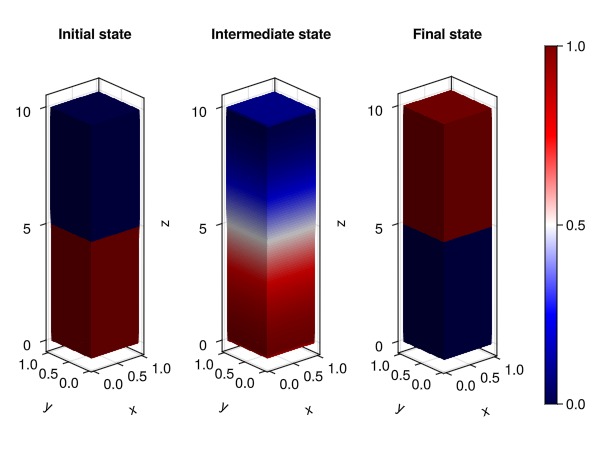Gravity segregation example
Immiscible IntroductionThe simplest type of porous media simulation problem to set up that is not trivial is the transition to equilibrium from an unstable initial condition. Placing a heavy fluid on top of a lighter fluid will lead to the heavy fluid moving down while the lighter fluid moves up.
Problem set up
We define a simple 1D gravity column with an approximate 10-1 ratio in density between the two compressible phases and let it simulate until equilibrium is reached. We begin by defining the reservoir domain itself.
using JutulDarcy, Jutul
nc = 100
Darcy, bar, kg, meter, day = si_units(:darcy, :bar, :kilogram, :meter, :day)
g = CartesianMesh((1, 1, nc), (1.0, 1.0, 10.0))
domain = reservoir_domain(g, permeability = 1.0*Darcy);Fluid properties
Define two phases liquid and vapor with a 10-1 ratio reference densities and set up the simulation model.
p0 = 100*bar
rhoLS = 1000.0*kg/meter^3
rhoVS = 100.0*kg/meter^3
cl, cv = 1e-5/bar, 1e-4/bar
L, V = LiquidPhase(), VaporPhase()
sys = ImmiscibleSystem([L, V])
model = SimulationModel(domain, sys);Definition for phase mass densities
Replace default density with a constant compressibility function that uses the reference values at the initial pressure.
density = ConstantCompressibilityDensities(sys, p0, [rhoLS, rhoVS], [cl, cv])
set_secondary_variables!(model, PhaseMassDensities = density);Set up initial state
Put heavy phase on top and light phase on bottom. Saturations have one value per phase, per cell and consequently a per-cell instantiation will require a two by number of cells matrix as input. We also set up time-steps for the simulation, using the provided conversion factor to convert days into seconds.
nl = nc ÷ 2
sL = vcat(ones(nl), zeros(nc - nl))'
s0 = vcat(sL, 1 .- sL)
state0 = setup_state(model, Pressure = p0, Saturations = s0)
timesteps = repeat([0.02]*day, 150);Perform simulation
We simulate the system using the default linear solver and otherwise default options. Using simulate with the default options means that no dynamic timestepping will be used, and the simulation will report on the exact 150 steps defined above.
states, report = simulate(state0, model, timesteps);Jutul: Simulating 3 days as 150 report steps
╭────────────────┬───────────┬───────────────┬──────────╮
│ Iteration type │ Avg/step │ Avg/ministep │ Total │
│ │ 150 steps │ 150 ministeps │ (wasted) │
├────────────────┼───────────┼───────────────┼──────────┤
│ Newton │ 1.78 │ 1.78 │ 267 (0) │
│ Linearization │ 2.78 │ 2.78 │ 417 (0) │
│ Linear solver │ 1.78 │ 1.78 │ 267 (0) │
│ Precond apply │ 0.0 │ 0.0 │ 0 (0) │
╰────────────────┴───────────┴───────────────┴──────────╯
╭───────────────┬────────┬────────────┬────────╮
│ Timing type │ Each │ Relative │ Total │
│ │ ms │ Percentage │ s │
├───────────────┼────────┼────────────┼────────┤
│ Properties │ 0.0138 │ 0.36 % │ 0.0037 │
│ Equations │ 0.0208 │ 0.85 % │ 0.0087 │
│ Assembly │ 0.0078 │ 0.32 % │ 0.0033 │
│ Linear solve │ 0.1817 │ 4.76 % │ 0.0485 │
│ Linear setup │ 0.0000 │ 0.00 % │ 0.0000 │
│ Precond apply │ 0.0000 │ 0.00 % │ 0.0000 │
│ Update │ 0.0123 │ 0.32 % │ 0.0033 │
│ Convergence │ 0.0120 │ 0.49 % │ 0.0050 │
│ Input/Output │ 0.0112 │ 0.16 % │ 0.0017 │
│ Other │ 3.5426 │ 92.74 % │ 0.9459 │
├───────────────┼────────┼────────────┼────────┤
│ Total │ 3.8201 │ 100.00 % │ 1.0200 │
╰───────────────┴────────┴────────────┴────────╯Plot results
Plot the saturations of the liquid phase at three different timesteps: The initial, unstable state, an intermediate state where fluid exchange between the top and bottom is initiated, and the final equilibrium state where the phases have swapped places.
using GLMakie
fig = Figure()
function plot_sat!(ax, state)
plot_cell_data!(ax, g, state[:Saturations][1, :],
colorrange = (0.0, 1.0),
colormap = :seismic
)
end
ax1 = Axis3(fig[1, 1], title = "Initial state", aspect = (1, 1, 4.0))
plot_sat!(ax1, state0)
ax2 = Axis3(fig[1, 2], title = "Intermediate state", aspect = (1, 1, 4.0))
plot_sat!(ax2, states[25])
ax3 = Axis3(fig[1, 3], title = "Final state", aspect = (1, 1, 4.0))
plt = plot_sat!(ax3, states[end])
Colorbar(fig[1, 4], plt)
fig
Plot time series
The 1D nature of the problem allows us to plot all timesteps simultaneously in 2D. We see that the heavy fluid, colored blue, is initially at the top of the domain and the lighter fluid is at the bottom. These gradually switch places until all the heavy fluid is at the lower part of the column.
tmp = vcat(map((x) -> x[:Saturations][1, :]', states)...)
f = Figure()
ax = Axis(f[1, 1], xlabel = "Time", ylabel = "Depth", title = "Gravity segregation")
hm = heatmap!(ax, tmp, colormap = :seismic)
Colorbar(f[1, 2], hm)
f
Example on GitHub
If you would like to run this example yourself, it can be downloaded from the JutulDarcy.jl GitHub repository as a script, or as a Jupyter Notebook
This example took 3.075365194 seconds to complete.This page was generated using Literate.jl.